Partner Toolkit

Partner With Us
Join us as a Think. Test. Treat TB partner and use your voice and platforms to deliver TB messages. Our partners include state and local health departments, TB Elimination Alliance, TB Centers of Excellence, the National TB Controllers Association, Stop TB USA, We are TB, and other organizations.
The Think. Test. Treat TB partner toolkit provides free resources in English and Vietnamese, including TB messages, digital and print resources, social media content, patient and provider education materials, and other materials for healthcare providers and partners to support TB communication, testing, and treatment efforts. In addition to the partner toolkit, a Campaign Resource Overview [PDF – 2 MB] provides a list of materials available for download and print.
Use these resources to share TB information with your partners. Examples include:
- Post Think. Test. Treat TB messages and use the hashtag #ThinkTestTreatTB on social media.
- Share Think. Test. Treat TB digital content, video public service announcement, and materials online.
- Use the sample articles to share Think. Test. Treat TB information with communities and healthcare providers in newsletters, emails, and other partner communications.
- Download and order free education materials for patients and healthcare providers.
- Educate communities at risk and healthcare providers at meetings, health fairs, conferences, and other events.
Subscribe to our email newsletter to receive updates, follow us on social media @CDC_TB on Twitter and @CDCTB on Facebook, download and share our partner letter and campaign resource overview [PDF – 2 MB], or contact us directly for more information on how we can think, test, and treat TB in our communities.
Visit the About the Campaign page to learn more about the Think. Test. Treat TB campaign, and support the materials included in this partner toolkit.
Key Messages
We encourage you to use the messages below for both general audiences and healthcare providers in communications materials and media to help increase awareness and understanding about latent TB infection.
For General Audiences and Media:
TB Risk
- Tuberculosis (TB) is one of the world’s leading infectious disease killers.
- TB germs are spread through the air when someone with active TB disease coughs, talks, or sings. People nearby may breathe in the TB germs and become infected.
- TB can live in your body for years without symptoms but can become active anytime and make you sick. This is called inactive TB or latent TB infection.
- Up to 13 million people in the United States have inactive TB, also known as latent TB infection.
- You may be at risk for TB even if you have received the TB vaccine (also called the BCG vaccine) because its protection weakens over time.
- TB is common throughout the world, but if you’re born in Asia, Africa, or Latin America, you have a higher chance of getting infected with TB because it’s more common in these regions.
- It’s important to talk with your healthcare provider about your risk for TB.
TB Testing and Treatment
- Without treatment,1 in 10 people with inactive TB will get sick in the future. More than 80% of people who get sick with active TB disease in the United States each year get sick from long-standing, untreated inactive TB, which can develop into active TB disease years or even decades later.
- Inactive TB can be treated to prevent active TB disease. Short and convenient treatments are available that can help protect you and your loved ones from getting sick.
- Public and private healthcare plans may cover the costs of testing and treatment for TB infection.
- Talk to your doctor about testing for TB to protect yourself, your family and friends, and your community.
For Healthcare Providers:
Latent TB Infection
- People with latent TB infection do not have signs and symptoms of TB disease and cannot spread TB bacteria to others. However, if these bacteria become active and multiply, latent TB infection can develop into TB disease. Once active, TB can be spread from person to person through the air.
- The Centers for Disease Control and Prevention (CDC) and the U.S. Preventive Services Task Force (USPSTF) recommend testing people that are at increased risk for TB infection.
- As a trusted source of health information in your community, it’s important to initiate a conversation about latent TB infection and TB disease with your patients since there may be a lack of awareness about or stigma associated with these conditions.
- Contact your state or local TB program, the TB Centers of Excellence, or visit CDC’s latent TB infection resource hub for more information.
TB Testing
- It is estimated that up to 13 million people in the United States live with latent TB infection (also called inactive TB). Help reduce the risk of TB in your community. Open the conversation, protect your patients, and test for tuberculosis.
- There are two types of tests for latent TB infection: a blood test and a skin test. A blood test is the preferred option because it can be done in one visit and is the most accurate if patients have been vaccinated for TB in the past.
TB Treatment
- Without treatment, 1 in 10 people with latent TB infection will get sick in the future. You play a critical role in reducing the spread of TB in your community and the United States.
- If your patient tests positive for latent TB infection, it’s critical that you consider recommending shorter and more convenient treatments. While all the regimens are safe and effective, short course, rifamycin-based regimens are the preferred treatment options for latent TB infection because they have higher completion rates.
Testing and treating latent TB infection is a critical step to eliminating TB in the United States and protecting your community.
Sample Social Media Content:
Use our suggested Twitter, Facebook, Instagram and LinkedIn copy to spread the word. Schedule content to remind your networks about the importance of TB. Use #ThinkTestTreatTB to join the conversation and tag us at @CDC_TB on Twitter! Additional graphics are available in campaign resources.
For General Audiences:
Twitter Posts
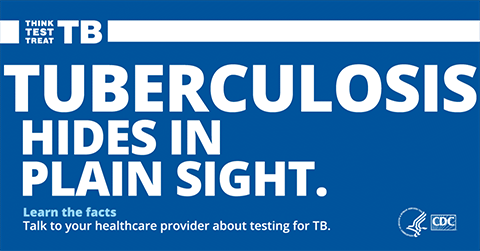
13M people in the U.S. have inactive TB and many don’t know it. If untreated, 1 in 10 people with inactive TB can develop active TB disease and spread it unknowingly. Learn how to protect yourself and others: [cdc.gov/ThinkTestTreatTB] #ThinkTestTreatTB
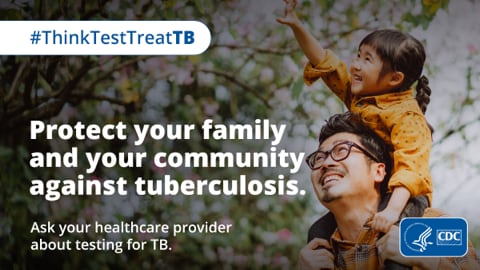
Without treatment, inactive TB can develop into active TB disease. People can become sick and may unknowingly pass TB to others, including friends, family, or healthcare workers. Learn how to protect yourself and others: [cdc.gov/ThinkTestTreatTB] #ThinkTestTreatTB
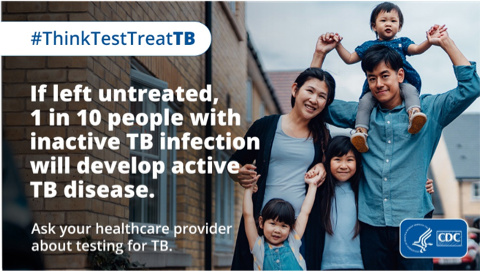
Active TB disease is highly contagious and can be deadly. Getting tested for TB can protect yourself, your family and friends, and your community: [cdc.gov/ThinkTestTreatTB] #ThinkTestTreatTB
Facebook Posts
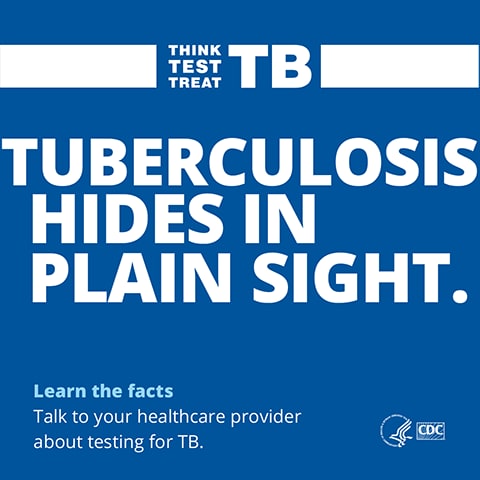
13M people in the U.S. have inactive TB and many don’t know it. Talk to your healthcare provider about preventing TB and learn more about protecting yourself and others: [cdc.gov/ThinkTestTreatTB]
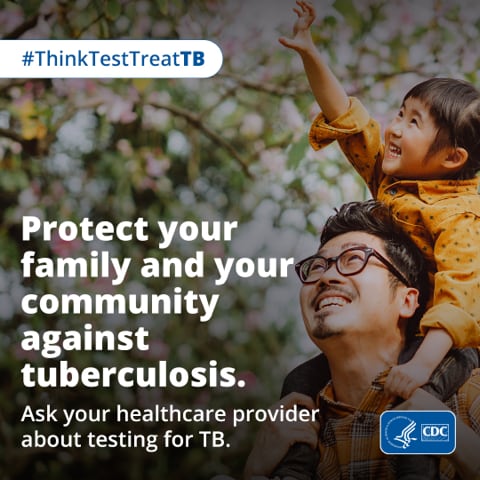
Without treatment, inactive TB can develop into active TB disease and spread to your community. Learn how to protect yourself and your loved ones: [cdc.gov/ThinkTestTreatTB]
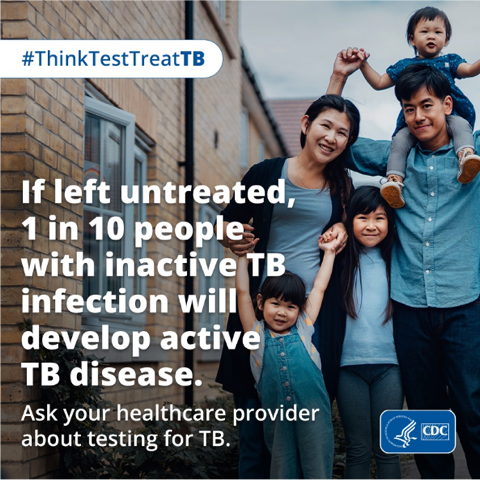
Active TB disease is highly contagious and can be deadly. Getting tested for TB can protect yourself, your family and friends, and your community: [cdc.gov/ThinkTestTreatTB]
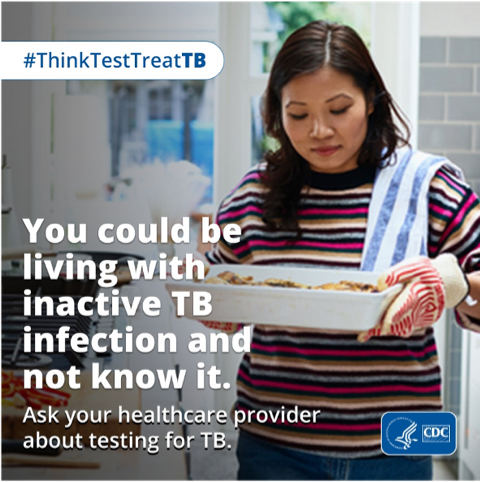
Inactive TB can live in your body for years without symptoms but can develop into active TB disease at any time and make you sick. Ask your healthcare provider about testing for TB. [cdc.gov/ThinkTestTreatTB]
Instagram Posts

13M people in the U.S. have inactive TB and many don’t know it. Talk to your healthcare provider about preventing TB and learn more about protecting yourself and others: [cdc.gov/ThinkTestTreatTB] #ThinkTestTreatTB
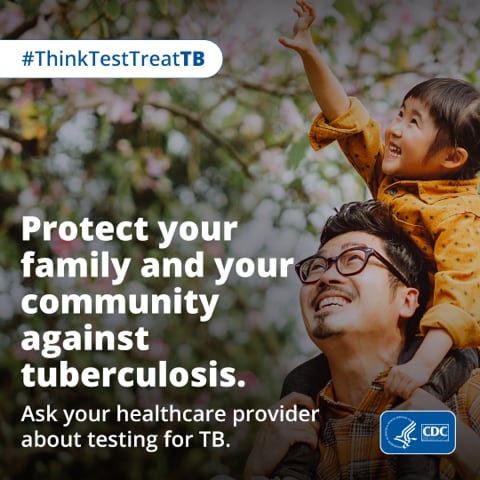
Without treatment, inactive TB can develop into active TB disease and spread to your community. Learn how to protect yourself and your loved ones: [cdc.gov/ThinkTestTreatTB]
LinkedIn Posts
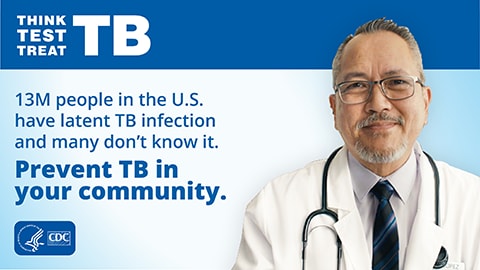
13M people in the U.S. have inactive TB infection and many don’t know it. Talk to your healthcare provider about preventing TB and learn more about protecting yourself and others: [cdc.gov/ThinkTestTreatTB]
For Healthcare Providers:
Twitter Posts
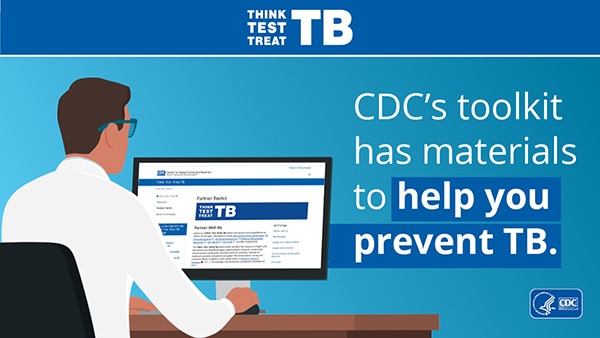
Up to 13 million people are living with latent TB infection in the U.S. and if left untreated, 1 in 10 of those will develop active TB disease in the future. Learn how to protect your community today. [cdc.gov/ThinkTestTreatTB] #ThinkTestTreatTB
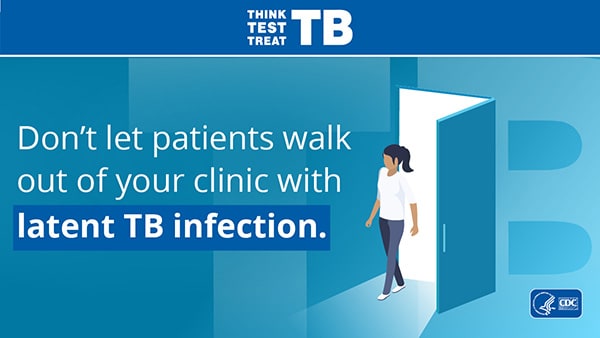
If you’re a healthcare provider, talk to your patients about the risk factors of latent TB infection. [cdc.gov/ThinkTestTreatTB] #ThinkTestTreatTB

Healthcare providers: help reduce the risk of tuberculosis in your community. Open the conversation, protect your patients, and test for tuberculosis. [cdc.gov/ThinkTestTreatTB] #ThinkTestTreatTB
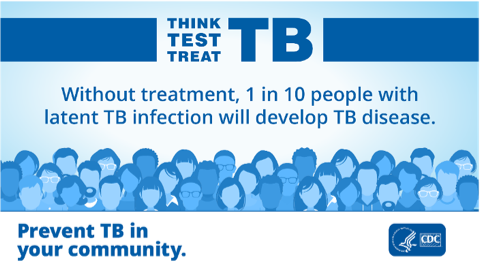
Healthcare providers: prevent TB disease! Open the conversation, protect your patients, and test for TB. Help reduce the risk of TB in your community. [cdc.gov/ThinkTestTreatTB] #ThinkTestTreatTB
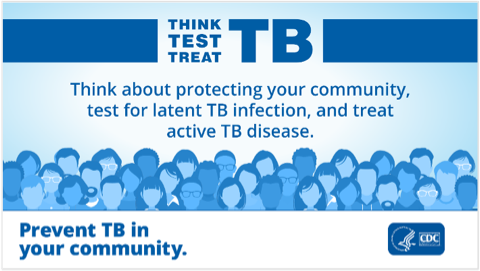
Healthcare providers: testing and treating latent tuberculosis infection is a critical step to eliminating TB disease across America. Start in your office – talk to your patients about testing for TB today. [cdc.gov/ThinkTestTreatTB] #ThinkTestTreatTB Download [1200 x 675px]
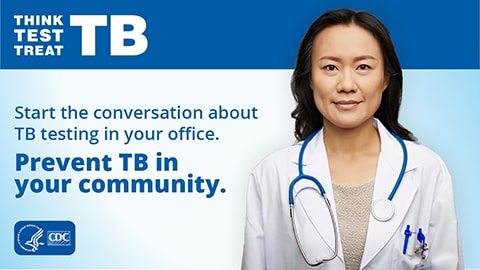
As a healthcare provider, you play an important role in protecting your patients from tuberculosis. Talk with them today about TB testing and treatment options. [cdc.gov/ThinkTestTreatTB] #ThinkTestTreatTB
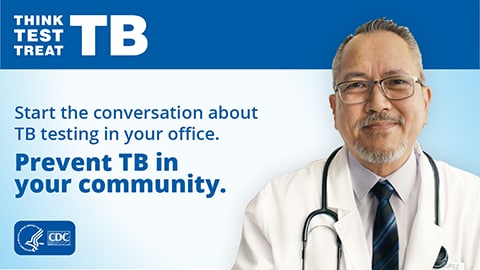
As a healthcare provider, you play an important role in protecting your patients from tuberculosis. Talk with them today about TB testing and treatment options. [cdc.gov/ThinkTestTreatTB] #ThinkTestTreatTB
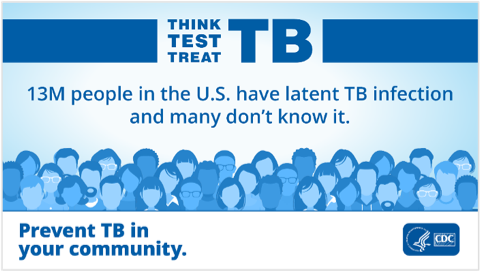
Latent tuberculosis infection can develop into active TB disease at any time. Healthcare providers can prevent the spread of TB by talking to patients about testing and treatment options. [cdc.gov/ThinkTestTreatTB] #ThinkTestTreatTB
Facebook Posts
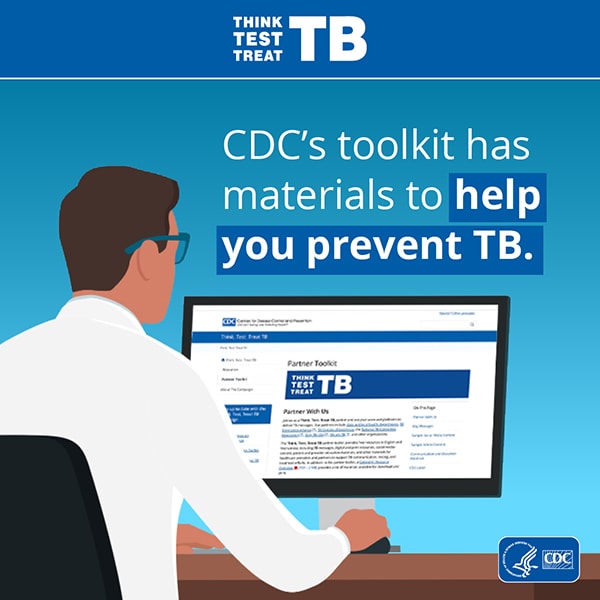
Up to 13 million people are living with latent TB infection in the U.S. and if left untreated, 1 in 10 of those will develop active TB disease in the future. Learn how to protect your community today. [cdc.gov/ThinkTestTreatTB]
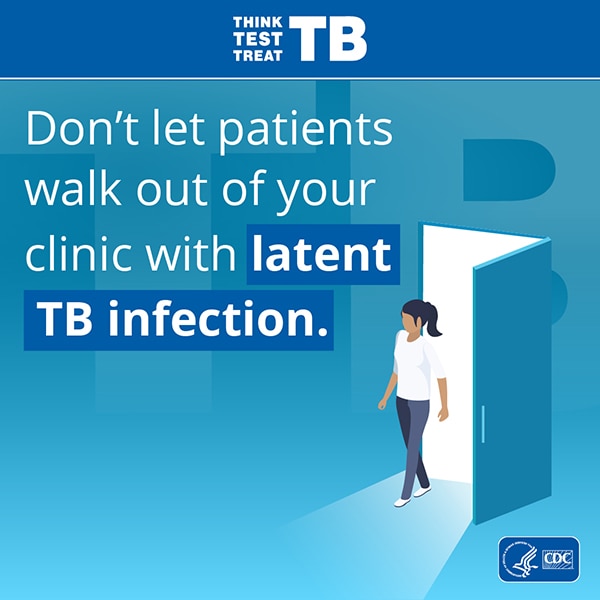
If you’re a healthcare provider, talk to your patients about the risk factors of latent TB infection. [cdc.gov/ThinkTestTreatTB]
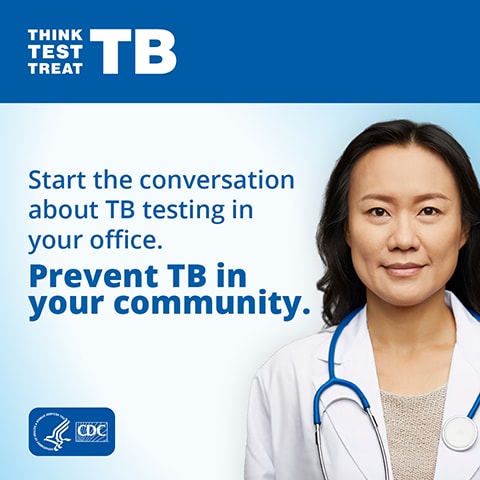
As a healthcare provider, you play a critical role in reducing the spread of tuberculosis in the U.S. and your community. Protect your patients. [cdc.gov/ThinkTestTreatTB]
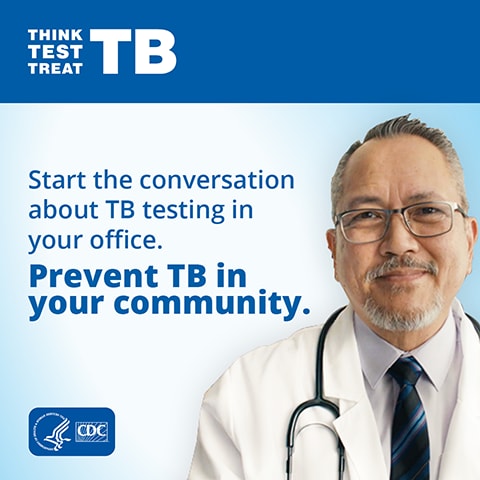
As a healthcare provider, you play an important role in protecting your patients from tuberculosis. Talk with them today about TB testing and treatment options. [cdc.gov/ThinkTestTreatTB]
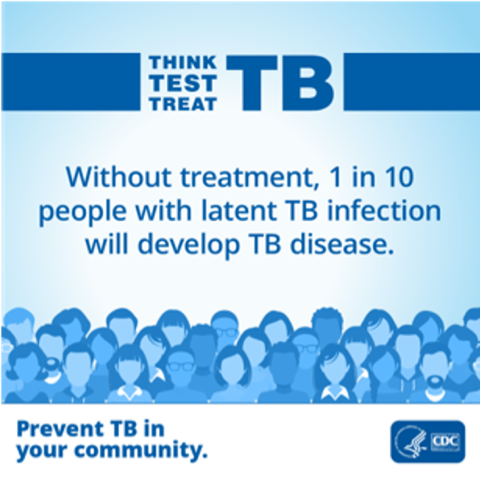
As a healthcare provider, you play an important role in protecting your patients from tuberculosis. Talk with them today about TB testing and treatment options. [cdc.gov/ThinkTestTreatTB]
Instagram Posts
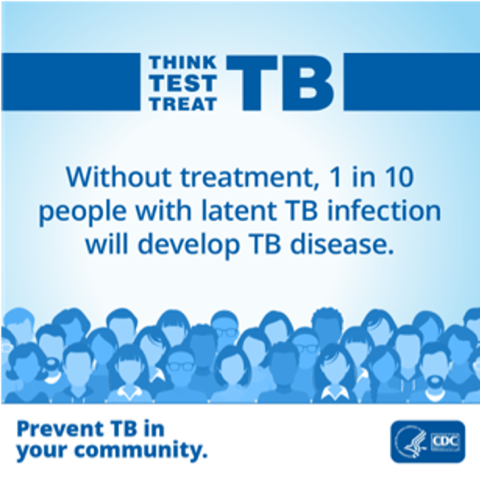
As a healthcare provider, you play an important role in protecting your patients from tuberculosis. Talk with them today about TB testing and treatment options. [cdc.gov/ThinkTestTreatTB]

As a healthcare provider, you play an important role in protecting your patients from tuberculosis. Talk with them today about TB testing and treatment options. [cdc.gov/ThinkTestTreatTB]

As a healthcare provider, you play an important role in protecting your patients from tuberculosis. Talk with them today about TB testing and treatment options. [cdc.gov/ThinkTestTreatTB]
LinkedIn Posts

Up to 13 million people are living with latent TB infection in the U.S. and if left untreated, 1 in 10 of those will develop active TB disease in the future. Learn how to protect your community today. [cdc.gov/ThinkTestTreatTB]

If you’re a healthcare provider, talk to your patients about the risk factors of latent TB infection. [cdc.gov/ThinkTestTreatTB]

As a healthcare provider, you play an important role in protecting your patients from tuberculosis. Talk with them today about TB testing and treatment options. [cdc.gov/ThinkTestTreatTB]
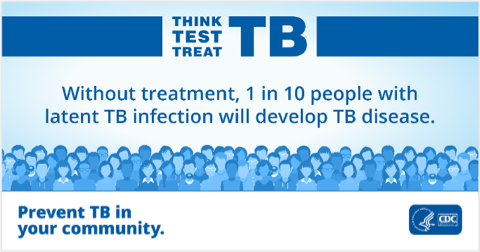
Healthcare providers: you can prevent tuberculosis! Open the conversation, protect your patients, and test for TB. Help reduce the risk of TB in your community. [cdc.gov/ThinkTestTreatTB]
Sample Article Content
Include our sample content in email or print newsletters or other communications channels, including updates to staff, provider networks, associations, and community-based communications efforts.
For General Audiences:
TB can live in your body for years without causing symptoms. This is called inactive TB or latent TB infection. Up to 13 million people in the United States are living with inactive TB and many don’t know it.
[insert local HCP quote]
People with inactive TB, or latent TB infection, don’t have signs and symptoms of TB disease and cannot spread TB bacteria to others. However, if these bacteria become active and multiply, inactive TB can develop into active TB disease. Once TB becomes active, it can spread from person to person through the air.
Anyone can get TB, but you have a higher risk for TB if you:
- recently spent time with someone who has active TB disease
- were born in or who frequently travel to countries where TB disease is common, including those in Asia, Africa, and Latin America
- work or live in places with high risk for TB transmission, such as hospitals, homeless shelters, correctional facilities, and nursing homes
- live or used to live in large group settings where TB is more common, such as homeless shelters, prisons, or jails
If you are at risk, talk to your doctor. The good news is that simple testing can determine if you have inactive TB, and there are several short and convenient treatment options that can protect you from getting sick. Public and private healthcare plans may cover the costs of testing and treatment for TB infection. Help stop the spread to protect yourself, your loved ones, and your community.
For more information on tuberculosis or the #ThinkTestTreatTB campaign visit the website.
For Healthcare Providers:
Testing and treating latent TB infection is a critical step to protecting your community and reducing the spread of TB in the United States. As a trusted source of health information, it’s important to initiate a conversation about latent TB infection and TB disease with your patients at risk for TB, since there may be a lack of awareness about or stigma associated with these conditions. Testing for TB infection should be part of their regular medical care.
Here are 4 tips for starting the conversation:
- Introduce TB & address potential misinformation
- Explain that people with latent TB infection do not have signs and symptoms of TB disease and cannot spread TB bacteria to others, but these bacteria could become active and multiply, developing into TB disease.
- Explain that once active, people with TB disease can feel sick and spread it through the air to family, friends, and other people they spend time with.
- Discuss your patient’s risk
- There are several risk factors for TB, so it’s important to talk with your patients about their risk based on:
- areas of the world where TB is common (particularly Asia, Africa, and Latin America)
- exposure to individuals at higher risk (living or working in homeless shelters, prisons, or jails)
- other health conditions they may have (such as diabetes or HIV).
- Explain the testing process
- There are two types of tests for latent TB infection: the TB blood test and the TB skin test.
- Explain that the blood test is preferred because it can be done in one visit, and it’s the most accurate if you’ve been vaccinated for TB in the past.
- Discuss treatment options
- If your patient is diagnosed with latent TB infection, consider recommending shorter and more convenient treatments. While all the regimens are safe and effective, short course, rifamycin-based regimens are the preferred treatment options for latent TB infection because they have higher completion rates.
- Support your patients to help them complete treatment for latent TB infection.
Without treatment, 1 in 10 people with latent TB infection will get sick with TB disease in the future. You play a critical role in eliminating TB in your community and the United States. Together we can Think. Test. Treat TB.
For more information on tuberculosis or the #ThinkTestTreatTB campaign visit the website.
Communication and Education Materials
Help us spread the word about TB. These materials are a collection of resources to use and share that provide information on TB and the importance of testing and treatment.
The Think. Test. Treat TB campaign includes numerous resources specifically designed for healthcare providers and their patients.
Download Digital Ads
View Think. Test. Treat TB PSA Videos
Download Print Ads
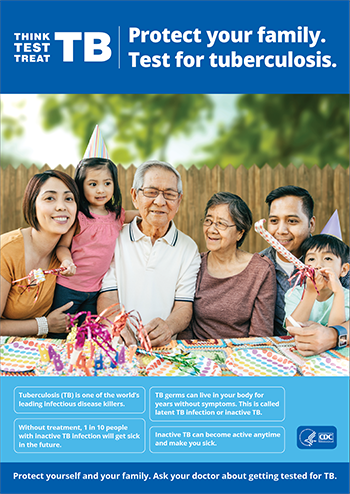
Protect your family. Test for tuberculosis. (Print Ad)
Overview of inactive TB to encourage TB testing.
Download Patient and Healthcare Provider Education Materials
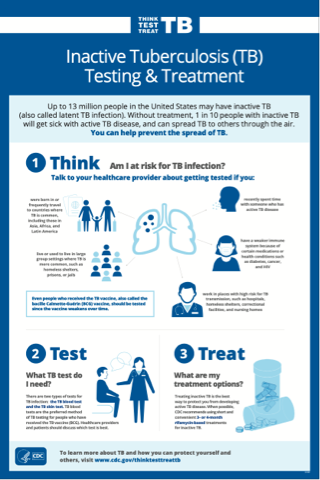
Inactive Tuberculosis (TB) Testing & Treatment (Poster)
One-page visual overview of the testing and treatment of inactive TB disease that can be used as a poster.
English PDF – 8.5×11 [550 KB]
English PDF – 11×17 [551 KB]
English PDF – 24×36 [552 KB]
Vietnamese PDF – 8.5×11 [288 KB]
Vietnamese PDF – 11×17 [303 KB]
Vietnamese PDF – 24×36 [300 KB]
Chinese PDF – 8.5×11 [231 KB]
Chinese PDF – 11×17 [345 KB]
Chinese PDF – 24×36 [708 KB]
Ilocano PDF – 8.5×11 [235 KB]
Ilocano PDF – 11×17 [328 KB]
Ilocano PDF – 24×36 [658 KB]
Marshallese PDF – 8.5×11 [188 KB]
Marshallese PDF – 11×17 [344 KB]
Marshallese PDF – 24×36 [664 KB]
Tagalog PDF – 8.5×11 [176 KB]
Tagalog PDF – 11×17 [331 KB]
Tagalog PDF – 24×36 [659 KB]
Spanish PDF – 8.5×11 [604 KB]
Spanish PDF – 11×17 [604 KB]
Spanish PDF – 24×36 [606 KB]
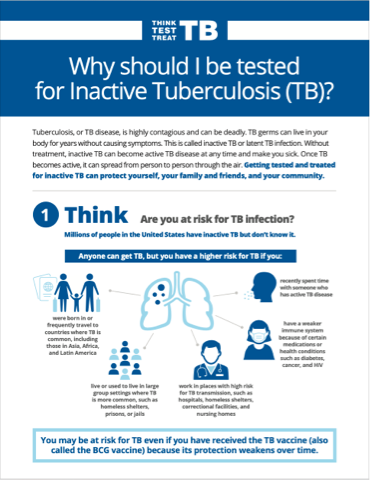
Why should I be tested for Inactive Tuberculosis (TB)? (Fact Sheet)
Detailed overview of the risk factors, testing process, and treatment options for inactive TB.
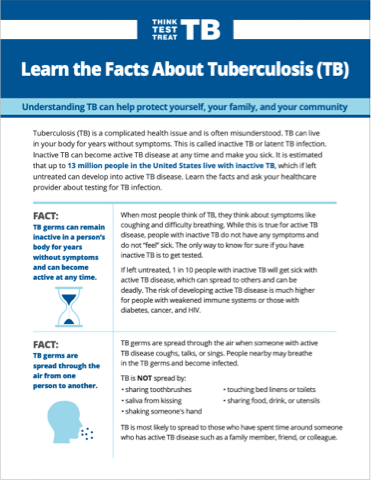
Learn the Facts About Tuberculosis (TB) (Fact Sheet)
Guide to understanding the myths and facts about inactive TB.
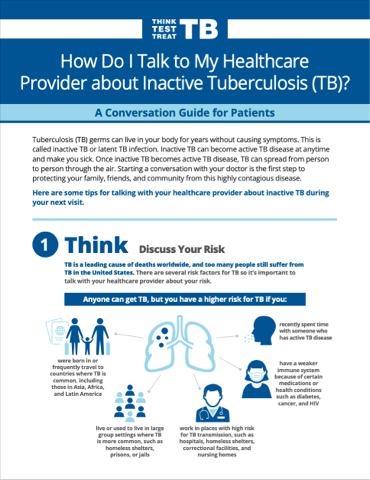
How Do I Talk to My Healthcare Provider about Inactive Tuberculosis (TB)? (Conversation Guide)
A conversation guide for patients about how to talk to healthcare providers about TB risk, understand the testing process, and discuss treatment options.
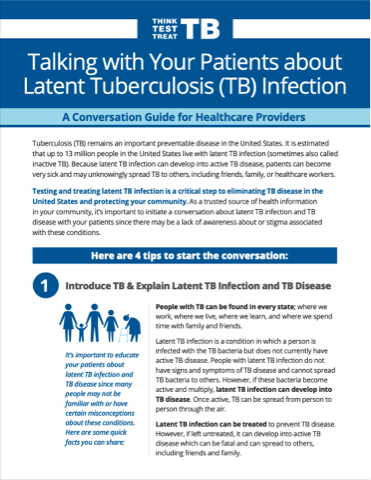
Talking with Your Patients about Latent Tuberculosis (TB) Infection (Conversation Guide)
A conversation guide for healthcare providers about how to talk to patients about latent TB infection.
CDC Letter
Read and share the letter below as an introduction to our Think. Test. Treat TB campaign and its resources.
Dear Public Health Partner,
Tuberculosis (TB) remains an important preventable disease in the United States.
The CDC estimates that up to 13 million people in the United States are living with latent TB infection (sometimes called inactive TB), and 1 in 10 of those people could develop active TB disease and spread it unknowingly. Testing and treating latent TB infection is a critical step to eliminating TB in the United States.
TB is also a disease of disparity, disproportionately impacting the Asian and Pacific Islander communities. This is an important public health issue that needs to be addressed to build healthier communities and achieve health equity.
We are excited to have your support on the Think. Test. Treat TB campaign, the first national communications campaign.
The Think. Test. Treat TB campaign includes resources in multiple languages and a partner toolkit to make it easy for you and your organization to promote testing and treatment of inactive TB. The toolkit contains:
- Key messages for general audiences, media, and healthcare providers
- Social media content for both general audiences and healthcare providers (Twitter, Facebook, Instagram, and LinkedIn)
- Sample language for newsletters or other communications channels, including updates to staff, provider networks, associations, and community-based communications efforts
- A video PSA showing a conversation about TB testing between a patient and healthcare provider
- Educational materials, including conversation guides for both patients and healthcare providers
We encourage you to use the toolkit to help spread the word within your networks. Thank you for your partnership and commitment to TB elimination.
/Philip LoBue, MD, FACP, FCCP/
Director
Division of Tuberculosis Elimination
National Center for HIV, Viral Hepatitis, STD, and TB Prevention
U.S. Centers for Disease Control and Prevention
Looking for resources to Think. Test. Treat TB for patients, providers, and partners?
Materials are available free of charge for order via CDC-Info On Demand Publications (see ordering instructions).